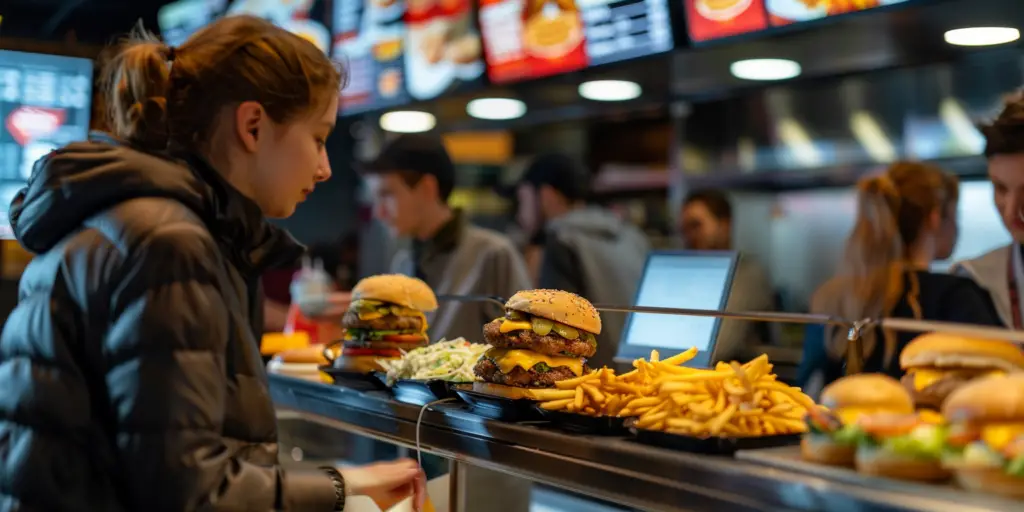The fast food industry in the United States stands as a significant component of the nation’s economy and cultural identity, shaped by decades of evolution, consumer trends, and economic factors. As we look towards the future, the industry faces both challenges and opportunities in adapting to a rapidly changing market landscape. This article delves into the current state of the fast food industry, emerging trends, and the future outlook for businesses within this sector in the USA.
How are the Fast Food Giants competing in this market?
In the highly competitive fast-food industry, leading chains are constantly vying for market share and customer loyalty. This cutthroat competition drives innovation, efficiency, and strategic maneuvering as each brand seeks to outpace its rivals. Below, we explore how these companies are engaging in neck-to-neck competition and the strategies they employ to stay ahead in the market.
1. Embracing Technological Advances
One of the key battlegrounds is technology. Fast food chains are leveraging digital ordering, mobile apps, and delivery platforms to enhance customer convenience and streamline operations. McDonald’s, for example, has heavily invested in its mobile app, offering exclusive deals and seamless ordering to encourage repeat business.
Similarly, brands like Starbucks and Domino’s have integrated advanced ordering technologies and loyalty programs, making it easier for customers to place orders and earn rewards, fostering customer loyalty and repeat visits.
2. Menu Innovation and Diversification
Menu innovation is another critical area where fast food chains compete. The introduction of new, limited-time offerings keeps the menu fresh and enticing for customers. McDonald’s is renowned for its creative menu items and limited-time offers, which generate buzz and attract customers eager to try new flavors. Additionally, there’s a growing trend towards healthier, more diverse menu options to cater to a wider range of dietary preferences. Chains like Chipotle and Panera Bread emphasize fresh, high-quality ingredients, vegetarian, and vegan options, appealing to health-conscious consumers.
3. Marketing and Branding Efforts
Effective marketing and branding are essential for maintaining visibility and relevance in the fast food industry. Chains employ a mix of traditional advertising, social media engagement, and creative campaigns to connect with customers. Taco Bell’s innovative marketing strategies, such as pop-up experiences and merchandise, not only promote their brand but also create a unique culture around their food. Similarly, Wendy’s uses witty and often cheeky social media interactions to engage consumers, setting itself apart from competitors.
4. Focus on Health and Sustainability
Responding to consumer demands for healthier options and ethical practices, fast food chains are reformulating existing items and introducing new, healthier options. Chipotle is an example of a fast food chain that emphasizes fresh, non-GMO ingredients and transparent sourcing practices, appealing to health-conscious consumers. Similarly, chains like Panera Bread highlight the nutritional value of their offerings and commit to clean ingredients, addressing consumer concerns about health and wellness.
5. Global Expansion
While not unique to the U.S. market, global expansion is a strategy used by fast food giants to maintain growth and diversify risk. McDonald’s, KFC, and Domino’s, among others, have a significant international presence, allowing them to tap into new markets and customer bases. This global approach not only offsets domestic market saturation but also allows chains to experiment with region-specific menu items that can inform innovations back home.
6. Customer Experience and Convenience
Finally, the fast food industry is increasingly focused on enhancing customer experience and convenience. This includes everything from improving food quality and service speed to ensuring a pleasant and hygienic dining environment. The COVID-19 pandemic accelerated the shift towards contactless delivery, drive-thru, and curbside pickup options, with chains like McDonald’s and Chick-fil-A expanding their drive-thru lanes and offering contactless services to ensure customer safety and convenience.
The Present State of Fast Food in the USA
The fast food industry in the USA is characterized by its diversity, convenience, and widespread appeal. Dominated by giants such as McDonald’s, Burger King, Taco Bell, and Wendy’s, the industry serves millions of Americans daily. These chains have thrived by offering quick, affordable meal options that cater to a broad spectrum of tastes and preferences. However, the industry is also seeing significant shifts in consumer behavior, with a growing demand for healthier, high-quality food options and sustainable practices.
Emerging Trends Shaping the Future
Health and Wellness Focus
One of the most pronounced trends is the increasing consumer demand for healthier eating options. This shift has prompted fast food chains to introduce more nutritious menu items, including salads, fruit, and vegetarian or vegan alternatives. The future success of fast food businesses will likely hinge on their ability to balance traditional offerings with healthier, quality food options to meet this evolving consumer demand.
The Future Outlook
The future of the fast food industry in the USA appears to be one of adaptation and innovation. Businesses that can successfully navigate the changing consumer landscape by offering healthier options, leveraging technology, and committing to sustainability are poised for growth. Moreover, the industry’s resilience and ability to quickly adapt to new trends and economic conditions suggest that fast food will remain a staple of the American diet.
However, the industry also faces potential challenges, including regulatory changes, labor shortages, and the rising costs of ingredients. Fast food businesses will need to remain agile, continuously seeking efficiencies in their operations and exploring new market opportunities.
Conclusion
As the fast food industry moves forward, it will undoubtedly continue to evolve in response to the dynamic preferences and values of American consumers. By embracing innovation, focusing on quality and sustainability, and leveraging technology, fast food businesses in the USA can look towards a future of continued relevance and success in the changing landscape of the American food industry. The journey ahead promises to be both challenging and exciting, with ample opportunities for those ready to adapt and innovate.

